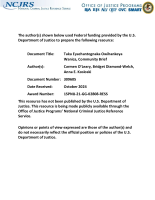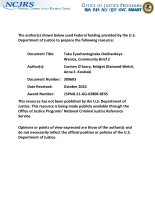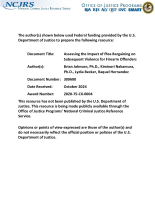Violence
Taku Eyachantognaka Owihankeya Wanica, Community Brief
Date Published
January 2024
Agencies
NIJ-Sponsored
Taku Eyachantognaka Owihankeya Wanica, Community Brief 2
Date Published
January 2024
Agencies
NIJ-Sponsored
Assessing the Impact of Plea Bargaining on Subsequent Violence for Firearm Offenders
Date Published
2024
Agencies
NIJ-Sponsored
Applying a Racial Lens to the "Cycle of Violence"
NCJ Number
309763
Journal
Child Maltreatment
Date Published
August 2024
Agencies
NIJ-Sponsored
Publication Link
Student Attempts of Violence Following a School Threat Assessment
NCJ Number
309729
Journal
Journal of School Violence
Date Published
October 2024
Agencies
NIJ-Sponsored
Publication Link
Neighborhood Disadvantage, Social Groups, and Adolescent Violence: Assessing Mechanisms in Structural-Cultural Theories
NCJ Number
309724
Journal
Justice Quartery
Date Published
June 2024
Agencies
NIJ-Sponsored
Publication Link
Discordant and Concordant Substance Use and Daily Partner Violence in Adolescent and Young Adult Relationships With Baseline Dating Violence
NCJ Number
309654
Journal
Journal of Adolescent Health
Date Published
July 2024
Agencies
NIJ-Sponsored
Publication Link
It's Not all or Nothing: Women's Differential Use of Help-Seeking Strategies in Response to Intimate Partner Violence
NCJ Number
309642
Journal
Journal of Family Violence
Date Published
September 2024
Agencies
NIJ-Sponsored
Publication Link
Supporting the Frontline Through Community Healing: ADVANCING SCIENCE ON VIOLENCE INTERVENTION OUTREACH AND TRAUMA EXPOSURE
Date Published
April 2024
Agencies
BJA-Sponsored









